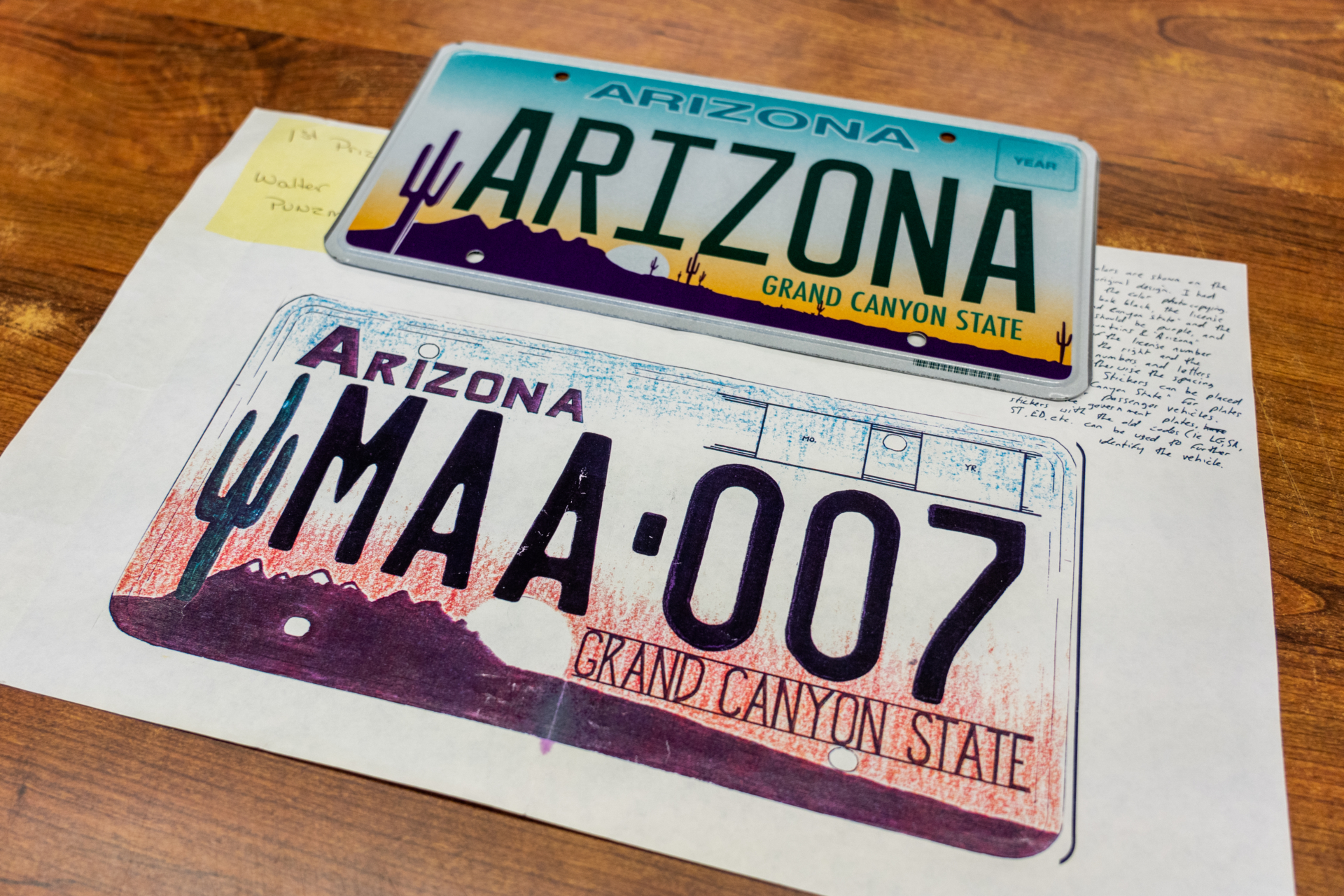With no art experience beyond high school classes, Walter Punzmann took out his pencil in the spring of 1990 and began sketching what he thought the Arizona license plate should look like. That sketch was then tucked away and forgotten about for some time.
Little did Punzmann know, the golden sunset, bold saguaro cactus and iconic mountain range he had drawn, would embellish Arizona’s passenger plate for more than 25 years.
Since 1909, Arizona has been through more than 50 different passenger plate designs, according to worldlicenseplates.com. But none were like the desert scene plate you see today.
“At the time in the 1990s, we [Arizona] were one of the last states still without a graphic plate,” said Clark Wothe, president of the Arizona License Plate Society.
The previous plates had been very basic: only featuring two colors with no graphic design.
But in the early 1990s, new technology allowed plates to be created on sheeting. Bill Beckett, an Arizona Motor Vehicle Division logistics administrator, described it as a large bumper sticker that could be applied to the plate with a thermal transfer process.
“That technology, for 1993, that was like highfalutin’ stuff,” Beckett said.
So in 1991, the state printed its first plate on the new sheeting technology: the environmental plate.
“It was completely different from what you saw in the maroon and white plate — it was really colorful, it had a little gecko on it and it looked really cool,” Beckett said. “That spurred the state to say ‘Hey, we really need to get a redesign done.’”
So, in 1993, a license plate design contest was held for all Arizonans to participate in, Beckett said. Over 1,500 designs were submitted, but it was Punzmann’s design that stood out the most.
The first draft Punzmann had drawn in 1990 featured a black mountain range, golden sunset and saguaro cactus in the middle. After hearing of ADOT’s contest three years later, Punzmann pulled out his Magic Markers and colored pencils, made some alterations and submitted three variations of the same concept.
“Just before I submitted my design, I made colored copies of it because I thought ,‘Eh, I’ll never see it again’,” Punzmann said. But in May 1993, it was announced that Punzmann had won.
The mountains were slightly altered, and six more cacti were added to the landscape. Other than that, Arizona’s passenger plate is very similar to the design that Punzmann submitted.
“The thing that I like about it is that it’s unique and it’s distinctive but yet it still meets the basic functionality of a plate — easy to read, easy to see, easy contrast,” Wothe said. “So many other states have come out with other designs that are so over the top or colors that just didn’t work.”
While the mountains depicted may resemble Four Peaks, Punzmann said they were actually inspired by the Silver Bell Mountains in Tucson.
Other than a weekend getaway to the Tempe Butte Hotel, Punzmann never received any financial compensation for his design.
Punzmann’s design was intended to be issued as the basic plate in 1994, but an overabundance of maroon plates prevented that.
“Someone at MVD found a huge stash of leftover maroon plates in a warehouse,” Wothe said. “Rather than shred all of these unused maroon plates, they continued to issue them.”
Because of this, Punzmann’s design was initially sold as a specialty plate until 1996, Wothe said. But Arizonans were willing to pay the extra cost.
“It was immediately popular when it came out,” Wothe said. “Vanity plate sales really went up because people really wanted this new design, but you couldn’t get it as a basic plate until August or September of ‘96.”
But with new technological advances, printing plates could be a thing of the past.
In January 2019, ADOT partnered with Reviver to be one of two states in the U.S. to offer digital license plates.
The Arizona digital plate still displays Punzmann’s design but in black and white.
The digital license plate offers many benefits such as an automatic license registration sticker and being able to display messages if the vehicle was stolen, Bickett said.
“Where I think it hinders, at least right now, is the cost,” Bickett said.
Reviver sells the basic digital plate for $499 and an additional $55 a year.
Regardless of how Punzmann’s design is displayed, he’s elated that it’s lasted over 25 years.
“I gotta tell you, it’s really fun seeing my artwork on everybody’s back bumper!” Punzmann said.




